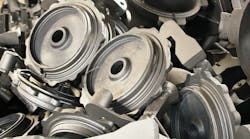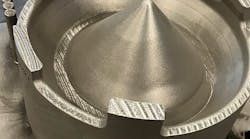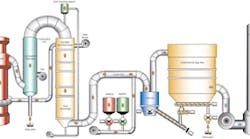Compliance should not mean complacence. To date, many North American metalcasting operations have set their sights on achieving environmental compliance with the federal MACT (maximum achievable control technology) standards, and many have met their objectives.
However, in many individual states, mercury emissions are being rigorously scrutinized by the state environmental agencies, presenting an additional standard for compliance by metalcasters in those jurisdictions. In ferrous foundry and steel mill operations where automotive scrap stokes cupola melters, mercury abatement is a very hot topic.
Although the federal Environmental Protection Agency has concerns regarding mercury exposure, it is not among the 300 hazardous air pollutants (HAPs) addressed by the federal MACT standards for cupola melting. This means that even if a foundry is MACT-compliant, they may not be ready to address their particular state’s requirements or achieve compliance with regard to mercury emissions.
State of the industry
Last year, New Jersey passed regulations stipulating that by 2010 all foundries and steel mills in that state will be required to meet a mercury-emission rate of 35 mg/ton of steel produced — that is, 75% control efficiency — by using mercury-free scrap metal. This can be done by installing and operating controls to an existing emission control system. Based on past practice and current industry conditions, it’s likely that other states will follow New Jersey’s example and establish similar control standards for mercury emissions.
The key to compliance for foundries and steel mills is using emissions-control technology that not only addresses the multitude of gaseous and particulate pollutants included in the federal MACT standard, but also achieve significant control over mercury emissions at the same time.
This is the challenge that Kuttner North America (www.kuttnerllc.com) embraces: to engineer customized emissions control systems that capture and remove those pollutants effectively and efficiently, but also to reduce energy usage and waste gases.
Kuttner’s approach starts with a basic understanding of combustion and temperature control. But, to achieve results that can exceed compliance, and significantly address mercury emissions, it’s important to have an intimate understanding of all of the variables within a system, from the cupola to the stack, and how all of those variables react with each other to generate results.
Kuttner’s gas cleaning systems offer:
• Collection of particulate in air and process gases;
• Dry and semi-dry chemisorption of acid gases (HF, HCI, SOx);
• Adsorption of PCDD/PCDF and heavy metals (Hg and Pb);
• Capture more than 90% of their vaporous mercury (depending on requirements.)
Reaction is critical
Kuttner’s solution uses Lhr’s patented baghouse technology (www.luehrfilter.de) and powdered activated carbon (PAC), a highly adsorbent form of carbon, to remove odors and emissions from liquids or gases. While PAC is a proven technology in mercury abatement, simply injecting carbon into the system is not enough to achieve a significant reduction in the volume of mercury emitted from the combustion process.
For PAC to be effective, an interaction must occur between the ionic mercury and activated carbon, and it must occur in a few precious seconds before the gases reach the bag filter. Kuttner uses a perforated conditioning drum filled with ceramic balls to provide the surface area for the reaction. As the drum rotates, it becomes a fluidized bed of material forcing a collision. The result is a significant amount of contact between the gases and the PAC, even in a short timeframe, and ultimately a higher degree of capture efficiency.
As an induced draft fan draws the gases to the baghouse, the Kuttner system uses a heat-recovery unit to cool the combustion gases down to a 280°F inlet baghouse temperature. The lower operating temperature and the ability to control the temperature of the gases are critical when attempting to remove mercury.
Traditionally, baghouse designs use water to cool the gas and control the temperature. In fact, competitive systems may use multiple spray towers within the overall process. To compensate for this water spray, these systems attempt to keep the temperatures elevated going into the house. Although this approach appears cost effective, over long periods of operation it has an adverse effect on the bags, and compromises the service life of the baghouse. In turn, this increases annual plant maintenance costs and capital expenses significantly
First, highly corrosive acid may form as condensation on the surface of the baghouse, compromising its structural integrity. It is not uncommon for the structure of a baghouse to become so unstable that they fall down on themselves. In addition, the higher temperatures within the baghouse cause the bags to become brittle and disintegrate. In extreme cases, a customer might need to replace the bags within six months; by contrast, bags used in the Kuttner process may last several years.
Kuttner’s oil-based cooling system delivers precise temperature control. The temperature needs to be somewhere between the acidic dewpoint for sulphuric acid and the temperature at which mercury will react with the PAC. If the temperature is too low, precipitating acid will become a problem. If it’s not cool enough, the vapor pressure of mercury will not reach a point low enough to capture it.
Baghouse design
The ability to form mercury particulate is only half of the challenge. Kuttner uses an innovative baghouse design from its sister company, Lhr Filter, to ensure its capture. The Luehr Filter bags are extremely compact and are packed tightly within the baghouse. More bags within the structure leads to a significant increase in the surface area available for filtration. To achieve an equivalent surface area, traditional baghouse designs may be so large they would not fit within a normal foundry application. Highly customizable, these installations are designed by Kuttner to fit into a very small footprint, yet still achieve an extremely high filter-surface area.
In addition, the Kuttner process controls the velocity at which the air flows through the filter. Moving very slowly, the air passing through the high surface area afforded by the Kuttner design leads to the highest possible efficiency. This is critical to the amount of dust collected and achieving the highest emissions control possible.
When designing an installation, Kuttner uses every possible advantage to generate better emissions capture, including the process of cleaning the filter bags.
A cleaning mechanism moves incrementally from row to row emitting a pulse of dry, compressed air that cleans the bags in small increments, without expanding the bag. The advantage is very little air volume goes offline from the process of capturing emissions at any given time, and a fine layer of filter cake is left on the bags. This approach maximizes the capabilities of the filter and minimizes the disruptions caused by offline cleaning.
The recycling nature of Kuttner’s baghouse also creates the potential for a high proportion of effluent dust recirculating in the system. This leads to increased mercury capture, but also significantly lowers overall operating costs. A higher ratio of recycling means less PAC needs to be purchased, and that there is less waste to be disposed.
Nothing wasted
Kuttner’s solution is designed to eliminate waste, to reduce operating expenses for ferrous foundries. Waste gas from cupolas and other thermal processes carry large amounts of heat energy. Often, this energy is simply wasted, emitted into the atmosphere without any ability to make it available to the operation.
It’s configured to allow the foundries to recover wasted heat, not only to use it within the emissions control system but also for various other applications, too (e.g., plant make-up air, core and paint drying, blast-air dehumidifying.) By having a complete understanding the overall process from cupola to stack, and innovative technology, nothing is wasted within the confines of the closed-loop system.
In a single package, Kuttner delivers significant particulate control, effectively addresses acidic gas emissions, reduces energy consumption, as well as operating and maintenance costs, and achieves greater than 90% capture of vaporous mercury, allowing customers to breathe easy.
| John Fieber is executive vice president of Kuttner North America, a single-source engineering company providing customized process and environmental solutions for metalcasting. Contact him at Tel. 262- 284-4483, or [email protected]. |












